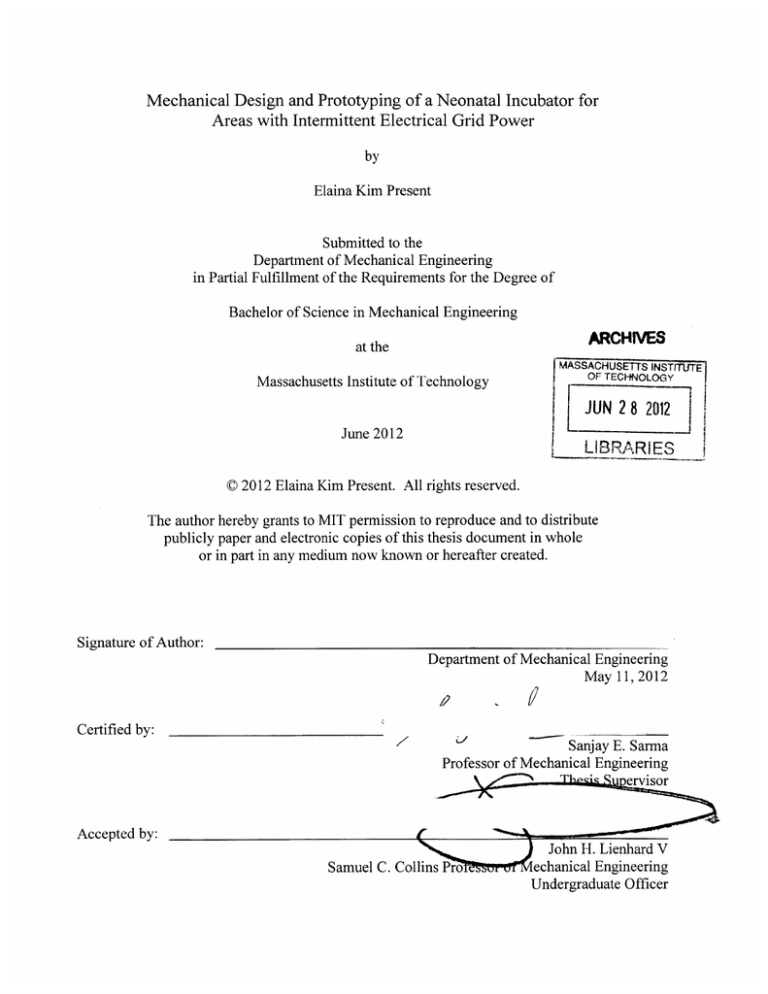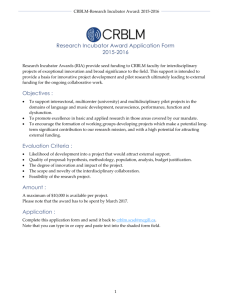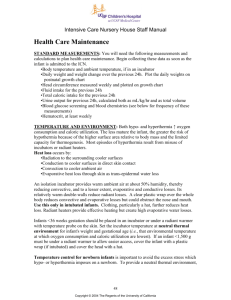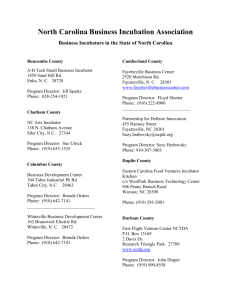Mechanical Design and Prototyping of a Neonatal ... Areas with Intermittent Electrical Grid Power
advertisement

Mechanical Design and Prototyping of a Neonatal Incubator for
Areas with Intermittent Electrical Grid Power
by
Elaina Kim Present
Submitted to the
Department of Mechanical Engineering
in Partial Fulfillment of the Requirements for the Degree of
Bachelor of Science in Mechanical Engineering
ARCHVES
at the
MASSACHUSETTS INST1TE
Massachusetts Institute of Technology
OF TECI-NOLOGY
JUN 28 2012
June 2012
LIBRA RIES
C 2012 Elaina Kim Present. All rights reserved.
The author hereby grants to MIT permission to reproduce and to distribute
publicly paper and electronic copies of this thesis document in whole
or in part in any medium now known or hereafter created.
Signature of Author:
Department of Mechanical Engineering
May 11, 2012
/2
Certified by:
(Sanjay
7l
E. Sarma
Professor of Mechanical Engineering
ervisor
Accepted by:
Samuel C. Collins Pro
John H. Lienhard V
echanical Engineering
Undergraduate Officer
Mechanical Design and Prototyping of a Neonatal Incubator for
Areas with Intermittent Electrical Grid Power
By
Elaina Kim Present
Submitted to the Department of Mechanical Engineering
on May 11, 2012 in Partial Fulfillment of the
Requirements for the Degree of Bachelor of Science in
Mechanical Engineering
ABSTRACT
Every year, 1.1 million infants die from complications related to preterm birth. An
estimated 80% of these deaths could be prevented through the use of non-intensive
methods, including thermal regulation. Neonatal incubators are common life-preserving
devices for preterm infants in developed countries, but are under-utilized in much of the
developing world due to designs intended for large hospital settings their need for constant
electrical grid power and. A design is here proposed for a portable off-grid neonatal
incubator for use in those areas. The design is honed through human-centered design
practices and the use of SolidWorks representations. Early-stage prototypes are
constructed from foam and ABS. Prototyping in ABS required overcoming difficulties
presented by the size constraints imposed by the thermoforming machines available in the
Laboratory for Manufacturing and Productivity.
Thesis Supervisor: Sanjay Sarma
Title: Professor of Mechanical Engineering
ACKNOWLEDGEMENTS
I would like to thank the staff of MIT's Laboratory for Manufacturing and Productivity for
their suggestions and help: Pat McAtamney, Bill Buckley, and especially Dave Dow, for his
patience and good humor throughout this process.
I would like to thank Subhrangshu Datta and Chitro Neogy for bringing their idea to MIT
and allowing a few undergrads to learn from it.
I would like to thank Delian Asparouhov and Stephanie Whalen for the complementary
work they've pursued.
I would like to thank Julia Hopkins for her support and proofreading.
I would like to thank Dick Fenner for his help in material procurement.
I would like to thank my advisor Professor Sanjay Sarma for encouraging me to have fun
with this project.
I would like to thank Stephen Ho for his patience, encouragement, and dedicated editing.
I would like to thank my parents and sister, for their love, support, and cookies throughout
my time at MIT.
And I would especially like to thank the MIT Shakespeare Ensemble, for reminding me how
useful cardboard can be.
5
6
CONTENTS
A b stra ct
.....................................................................................................................
Acknow ledgem ents
C on te n ts
...............................................................................................
5
7
...................................................................................................................
List of Im ages
..........................................................................................................
List of Tables
..........................................................................................................
Introduction
............................................................................................................
The Problem
The Project
M etrics of Success
D e sign
3
...................................................................................................
8
.8
9
9
..................................................................................................
10
....................................................................................................
13
..........................................................................................................................
14
The Incubator Unit
......................................................................................
14
The Docking Station
......................................................................................
18
Prototype m
.....................................................................................................
21
...................................................................................................
21
Foam M odel
l.s
...
21
ABS M odel
..........................................................................
Dem oA
y
.... ...........................................
Challenges
.......................................
................................................................
22
22
First Form ing Attem pt
...............................................................
24
Second Forming Attem pt
...............................................................
25
Flat Stock Work
..........................................................................
Lessons Learned from Com pleted Prototyping
Next Steps/Suggestions for Future W ork
.......................................
.............................................................
References....................................................31
7
28
29
30
LIST OF IMAGES
Figure 1: FrontierMed Technologies' Cosmetic Anya Prototype, Photographs ......
12
Figure 2: Incubator Unit, Side View, SolidWorks
15
.................................................
Figure 3: Bottom View of Incubator, Showing Threading of Straps, Sketch ............
16
Figure 4: Layers Inside the Incubator Base, Sketch
16
Figure 5: Docking Station, Sketch
.......................................
..........................................................................
Figure 6: Docking Station, ISO, SolidW orks
..........................................................
19
20
Figure 7: Docking Station with Incubator Unit, ISO, SolidWorks ...........................
20
Figure 8: Foam Model, Photographs
22
.............................................................................
Figure 9: ABS Hood, First Forming Attempt, Photograph
.......................................
25
Figure 10: ABS Hood, Second Forming Attempt, Photographs .............................
27
Figure 11: ABS Hood Comparison, Photograph
..................................................
27
Figure 12: ABS Model Comparison, Photographs
...............................................
28
LIST OF TABLES
Table 1: Incubator Unit Design Criteria and Proposed Solutions
8
...........................
17
INTRODUCTION
The Problem
There are 15 million children born prematurely every year, between 28 and 37 weeks
gestation. Complications related to preterm birth lead to the death of 1.1 million of these
children - more than 3,000 a day(7). Over 80% of these deaths occur due to lack of nonintensive care, such as warmth or feeding support(6 ).
Humans in general are quite good at regulating their own body temperatures. When skin
sensors indicate the body is too warm, sweat works via evaporation to cool it down. When
the sensors indicate the body is too cool, shivering warms it. Infants, however, cannot
shiver, and so rely on less efficient, oxygen-intensive fat-oxidation processes to keep their
body temperatures up. However, premature infants have a much more difficult time
generating heat and regulating their own body temperature than full-term infants, because
much of the development necessary for this process does not begin until 32 weeks'
gestation(3). Children born before that time have effectively no way to heat themselves,
rendering common insulation-based methods of warming such as blankets and clothing
fruitless. Those children born between 32 and 37 weeks gestation have thermal regulatory
systems that are functioning beneath critical capacity. All premature infants, therefore,
need heat provided from an external source(4).
Neonatal incubators were developed in the early 20th century to provide heat to children
born prematurely(). By the mid-1940s, incubator use was common practice in hospitals in
the United States and United Kingdom(6). However, seventy years later, incubators are still
not a universal option because of their high price tag, dependence on reliable electricity,
and need for technical support and skilled operation. Portability poses another problem:
50% of all premature children are born at home worldwide, but transport incubators are
large contraptions designed with wheels intended for hospital hallways, well-maintained
roads, and professionally-staffed ambulances. Lack of reliable electric grids is another
significant issue, since incubators require constant electrical power to maintain a lifesustaining thermal environment.
9
These impediments to incubator usage contribute to an unequal survival rate for
premature infants across geographic regions. For instance, South Asia and sub-Saharan
Africa account for nearly two-thirds of premature births, and three-quarters of worldwide
deaths due to preterm birth complications( 6). The health workers and clinics that serve this
region need an option better suited to their operational environment: an incubator that is
affordable, portable, and operates through glitches or blackouts in the electric grid.
The Project
In order to improve the current situation, a new, portable, grid-independent incubator is
being developed using phase change material as the method of heating. It was begun under
the name Anya by a team of designers including Subhrangshu Datta and Chitro Neogy, both
alumni of MIT. Before the involvement of any members of the MIT mechanical engineering
department, they had developed both a very clear picture of the need for the product and a
clear working concept('). Anya is currently owned by FrontierMed Technologies.
Anya was intended to be usable anywhere - a home, a health clinic, or in transit from one to
the other. In order to achieve this, it was designed to have two distinct units: the incubator
unit and a docking station. The incubator unit, similar in size to a portable infant car seat,
could be brought by a birth attendant to preterm births, or by a health worker to a home
where a preterm birth had occurred.
The incubator consists of a portable, heated, closed bassinet with simple monitors for
temperature and heartbeat It has no electric plug, but instead uses a pack of carefully
selected phase change material to maintain its temperature. The pack of phase change
material can be heated by immersion in boiling water until it forms a liquid. It is then
placed back into its slot in the incubator unit, where it maintains a relatively constant
temperature as it freezes to a solid over the course of two or more hours. When the child is
removed from the incubator for feeding, the pack of phase change material can be remelted by re-immersion in boiling water.
The incubator unit has straps and handles, making it easy to transport by whatever means
are used locally. Thus family members can bring the child in the incubator to a hospital or
10
health clinic themselves if necessary without further specialized medical transport.
Whether by foot, train, rickshaw, shared van, motorbike, or any other type of
transportation, they can be assured that the child remains at a stable, life-preserving
temperature. The attribute of boiling water as the intended heat source greatly enhances
this transportability, as it is a common heat source - it can be found or created in any home
around the world, and is widely available at tea shops or food stands should a trip take
more than two hours.
The second unit of the system, the docking station, will be kept at hospitals and health
clinics. Unlike most current incubators, it has no stand or wheels, but sits atop a table. It
has an electronic interface that connects to the incubator unit and interfaces with an
Android smart device system so that health workers can easily monitor multiple infants
simultaneously. It also has an electric plug, making unnecessary the use of boiling water as
a primary heating mechanism when grid electricity is available.
Subhrangshu Datta and Chitro Neogy commissioned a cosmetic prototype of one design of
this concept, which is shown in Figure 1 in various configurations. Figures la and 1c show
size- and weight-accurate 2.5 and 4 lb preemie dolls in the closed incubator unit. Figure lb
shows the back side of the unit, where the phase change material compartment is located.
Figureld does not include the lid, and the metal plate separating the doll from the phase
change heating material can be seen. Figure le shows an empty incubator unit in a docking
station form.
Datta and Neogy brought the cosmetic prototype to small hospitals in India and solicited
feedback. I did not become involved with this project until well after their return, when
MIT Professor Sanjay Sarma gathered three undergraduate students to further the goals of
the project in an academic setting. Stephanie Whalen's SB Thesis of this year, Nonelectric,
Standalone Heating Elementfor an Infant Incubator details the heat transfer modeling of
the device as well as the search for a phase change material of suitable price and physical
properties. The monitoring and Android portions of the project were pursued as an
Undergraduate Research Opportunities Program (UROP) project by Delian Asparouhov. My
SB Thesis focuses on the mechanical aspects of the design.
11
(a)
(b)
(c)
(d)
I
(e)
Figure 1: FrontierMed Technologies' Cosmetic Anya Prototype, Photographs
12
The idea of using phase change material as a backup to electric grid power for an incubator
has been suggested before(2 ). However, none of those involved with this project are aware
of any transport-friendly incubator making use of a phase change material heating system,
or any incubator that uses phase change material as its primary method of temperature
maintenance.
METRICS OF SUCCESS
Goals for this project were determined at the outset by both industry and academic
personnel. As the project continued, goals were readjusted to focus on academic value.
Emphasis was placed throughout on the creation of a product that is safe, reliable, low-cost,
attractive, and easily manufacturable near where it will be used.
In the design process, a broad range of criteria for success are considered. The entire
system design focuses on the health of the child, prioritizing it as the foremost
consideration. That single focus indicates many necessary attributes. Operation must be
possible and intuitive for operators with little or no training. The unit must be easily
cleaned and sanitized to reduce the chance of transmitting infections to a child with a weak
immune system. The temperature of the incubator unit must be maintained, while ensuring
ventilation and air circulation to aid the child's breathing and reduce the risk of SIDS.
Beyond these absolutely essential criteria, there are many secondary considerations to
allow the product to function up to its potential in every environment in which it is
designed to operate. The incubator unit must be easy for family members to travel with,
regardless of form of transportation, including on foot. The infant must be held securely to
reduce the impulse of a family member to open the covered bassinet and restrain it
manually. Indicators, as well as the child, must be easy to see at all times, both by family
members and by healthcare workers at the clinic. The heating device must be able to be
exchanged without disturbing the infant. The interface between the incubator unit, the
docking station, and the Android platform must be seamless and intuitive. All this must be
achieved in a lightweight and cost-efficient device, with a target weight of under 5 kg and
cost of $150 at scale production(').
13
Many of these necessary attributes had begun to be addressed in the cosmetic prototype
that was brought to India, but many had not yet been discovered. Work was required on
every front.
DESIGN
The Incubator Unit
By redesigning the incubator unit using the same original concept and incorporating the
feedback received during its tour of India, I was able to make significant improvements in
all of the design criteria. As shown in Figure 1, the design used for the cosmetic prototype
had the overall shape of a modified cylinder lying on its side, with flat handles waterjetted
from sheet metal on the ends and a flattened bottom. Approximately two thirds of the
cylindrical top was made of clear plastic, allowing visual monitoring of the infant, while the
remaining third was opaque and stored the phase change material heating element. The
phase change material heating element was stored in the same compartment as the child,
accessible only by opening the entire top, and separated from the child by a slotted metal
barrier. The ends, supporting the handles, were opaque plastic. The base piece was
supported only by its own plastic - the handles were separate, self-contained units on each
end. Plastic-covered foam filled the base and formed a hollow suitable for a specific size of
child, with an elastic band of approximately two inches in width providing securement.
This design was compact, lightweight, and attractive, but had significant potential for
improvement. The placement of the heating element within easy reach of the infant posed a
risk for contact burns, as shown in Figure 1d, in which a size and weight accurate doll
representing a 4.5 lb prematurely-born infant is in direct contact with the metal plate
separating it from the phase change material. This placement also had the potential to
create temperature gradients in the incubator, did not provide any means of encouraging
airflow, and reduced the child's already cramped quarters. The lightly padded sheet metal
handles threatened to cut into the hands of the family member carrying it as the padding
became worn. The ability to see into the carrier was limited, as shown in Figure 1b. In
addition to these prospective design shortcomings, there were many aspects of the design
14
and performance that were not thoroughly considered, including the mechanical reliability
of plastic in the developing world and the method of heat introduction to the system in
cases when grid electricity was available. I attempted to address these issues in my
redesign.
The redesigned incubator unit (Figure 2) consists of an upper and a lower plastic portion
(hood and base), each manufacturable using vacuum forming or other thermoforming
processes, including blowmolding, a process which is common in many developing
countries for use in making plastic soda bottles. The plastic base has protruding feet as part
of the same unit. The feet are punched out after thermoforming, allowing for the threading
of the handles (see Figure 3), and for the drainage of any small amounts of liquid that may
come into the unit as a residue from washing or by other means.
Figure 2: Incubator Unit, Side View, SolidWorks
The outer tangent dimensions of the resdesigned carrier are 12"x12"x22". These
dimensions are consistent with feedback received in India, where it was observed that the
original design was well suited for very premature infants but did not accommodate the
full range of children it was intended to serve. Figures la, 1c, and 1d show the original
cosmetic prototype incubator unit first with a 2 lb micro-preemie realistic doll, then with a
4.5 lb premature realistic doll.
15
Figure 3: Bottom View of Incubator, Showing Threading of Straps, Sketch
Inside the base, there are several layers of material. On the bottom is a complete layer of
thermally-insulating foam, above that, a U-shaped piece of the same material. A cross
section of the interior of the base is shown in Figure 4. The redesigned phase change
material heating element consists of a tray with phase change material heating packs,
which is inserted through a hole on one end of the base. The tray has a shape that
complements the U-shaped foam, but is half its height. Above the U-shaped foam, an inch
beneath the top of the base, is a nylon mesh that is the surface for the infant This
construction with insulating foam on five of the six sides of the heating element increases
the fraction of heat that goes towards warming the infant. The design also allows the
heating element to be removed for re-melting in boiling water or exchanged for a second
heating element without disturbing the child or opening the warmed top chamber to
ambient air. By suspending the infant a small distance above the heating element rather
than placing the two next to one another, the possibility of surface burns being sustained is
greatly reduced. Such placement also greatly helps the circulation of the air in the unit, as
the less dense hot air naturally rises, thereby helping to heat the entire volume to a
consistent temperature while increasing air circulation, which reduces the risk of SIDS.
NO{
6"
Air Gap
Figure 4: Layers Inside the Incubator Base
16
The redesigned hood is a domed shape rather than the partial cylinder of the earlier
version. Replacing the half-cylinder arch-style top with a domed shape allows the child to
be seen from anywhere in the room and accommodates a wider variety of clinic setups,
allowing a supervisory eye to be more easily kept on the child at all times. The cut sheetmetal handles are replaced by a single 1.5" wide nylon strap that threads through the
hollowed feet on the bottom and retainer clasps on the ends of the base, then snaps to
itself, creating a complete loop. Two lengths of strap travel the entire length of the
incubator unit, distributing the load on the plastic and increasing the mechanical safety of
the unit. The heating element is kept securely in place during transport by the tension from
the strap. The nylon handles represent an improvement over the previous metal handles
because they are lightweight, secure, washable, ergonomic, and do not interfere with
tending to the infant or exchanging the heating element
Table 1: Incubator Unit Design Criteria and Proposed Solutions
Incubator Unit Design Criteria
Proposed Solution
Easy to Carry
Redesigned Handles
Washable
Modular Plastic, Nylon, and Coated Foam
Construction
Air Circulation
Heating Element Beneath Top Chamber
Reinforcement for Plastic Base
Nylon Straps Beneath Plastic Base
Hot Surfaces Don't Contact Child
Heating Element Beneath Top Chamber
Efficient Use of Heating Element
Heating Element Surrounded by Insulating Foam
17
The Docking Station
The docking station of the cosmetic prototype was at an even earlier stage of the design
process than the incubator unit. It consisted solely of a singleshaped piece of foam,
approximately in the shape of an extruded L. The long base of the L was grooved to allow
the incubator unit to rest securely upon it, while the trunk of the L rose above the incubator
unit, allowing the display to be visible when the portable unit was docked. Figure le shows
the cosmetic prototype incubator unit docked in the matched docking station. There were
plans to use the docking station to electrically maintain the temperature of the incubator
unit, but these were not fully developed.
Though aesthetically pleasing, this portion of the design required further development. The
docking station design severely limited the angles at which either the infant or the monitor
readouts could be seen. It was optimized for a specific clinic layout, in which multiple
incubators would be placed end to end, and monitor displays were only needed from
limited angles. The intended ability to use electric grid power, when available, to heat the
incubator unit was not fully thought out, and the proposal of introducing electricity into an
economically manufactured environment that had seen some use with an infant raised
some concern.
The first revision I made to the design was to forgo the use of electricity to heat the
incubator unit itself, instead using electricity in the docking station to prepare a spare
phase change material heating element to be exchanged with the one in the incubator unit
as necessary. This has the additional benefit of making the exchange of a solidified heating
element for a melted one a normal part of incubator operation, whether grid electricity is
available or not, and creates a built-in temperature check cycle.
The second issue I sought to address was the lack of visibility of both the infant and the
monitor readouts. Figure 5a shows a sketch of an early plan, in which a single vertical pole
with a display rose above the incubator unit for at-a-glance updates and the dock for the
smart device was at platform level. Though an improvement, new concerns developed that
a large docked tablet smart device could block access to the infant, and that significant loss
18
of aesthetic value had occurred. These concerns led to further redesigns to the design
shown in Figures 5b, 6, and 7.
;-
Electronic
Guide
Curves
Data Port for
Incubator
/
Nurse's At-A-Glance Station
Android Dock
Plug
Heating Element
(a)
(00
Android Dock
.
Gd
Guide
High Enough to Clear
Carrier Handle
(no finger knocking)
Plug
Heating Element
(b)
Figure 5: Docking Station, Sketch
The redesigned docking station consists of a large plastic base with guide track grooves and
two vertical plastic loops. The feet of the incubator unit are designed to fit into the guide
tracks so that, when the unit is pushed backwards, the uncapped electronics port will align
with the electronics input port on the lower vertical loop of the docking station. The port
for the smart device is on the upper vertical loop of the docking station, visible above the
closed incubator unit from any angle from which the screen of the device can be read.
Sensor-integrated lights on the upper corners of the upper vertical loop can be seen from
anywhere in the room.
This docking station provides no risk of electric shock for the infant, as the method of
temperature control of the incubator unit is identical to the method when the unit is used
19
independently of the docking station. The combination of the domed top and hollowed
smart device dock allow the infant to be seen from any angle of the room, and to be
accessed from any side, increasing the ability of the docking station to adapt to any hospital
or health clinic environment.
Figure 6: Docking Station, ISO, SolidWorks
In addition to electrically heating a spare phase change material heating element when grid
power is available, the redesigned docking station is designed to allow easy monitoring of
the infant, or of several infants, through direct visual means as well as integration with an
Android smart device.
(a)
(b)
Figure 7: Docking Station with Incubator Unit, ISO, SolidWorks
20
PROTOTYPE
Creating useful prototypes of the size and approximate materials desired for this project
proved to be a significant challenge. Sources are detailed for any materials in this section
that proved troublesome to acquire, to aid in the work of any future student pursuing
similar projects.
Demo Baby
It was important to obtain a size- and weight-accurate doll for testing purposes. The system
is designed to be used with infants of a range of sizes, from the smallest viable human up
through sickly children of normal birth size and weight. Birth weight dolls are somewhat
expensive, though generally available, but dolls of accurate size and weight for premature
infants are difficult to find. Eventually, dolls representative of infants born at two different
premature gestations, a 4.5 lb "preemie" and 2 lb "micro-preemie" were purchased through
the Web Store of the BabyWearing Institute in Utah for reasonable prices. These dolls are
visible in Figures la, 1c, and 1d.
Foam Model
A foam model was constructed to provide a full size 3-D visualization of the redesign.
Materials used were
" foam board, DOW blue foam buoyance billets, masking tape, duct
tape, and cotton string. The foam board was purchased from Artist Supply near Central
Square. The blue foam was acquired from Dick Fenner in the Pappallardo Laboratory,
though is also available from various marine supply stores in the Boston area.
The foam board was used to represent the plastic portions of the carrier. Because foam
board does not easily make curves, a truncated pyramid was used to represent the domed
hood. The blue foam was used to represent the interchangeable phase change material
heating element insert and the high thermal resistance foam padding. The heating element
is shown in the model incubator unit in Figures 8a and 8c, and beside it in Figure 8b.
Figure 8d does not include the insert. The blue foam was cut using the hot-wire cutter in
21
the Product Design Lab (MIT room 35-452) run by Professor David Wallace. Duct tape was
used to represent the feet as well as to hold all blue foam parts together. String was used to
represent the nylon strap. Masking tape held all foam board portions together, and acted as
the hinges.
(a)(b
(c)(d
Figure 8: Foam Model, Photographs
ABS Model
Challenges
Following the completion and approval of the foam model, the next logical step is the
construction of a looks-like, works-like model: a model made of similar materials and of
similar shape and feel as the final is intended to be, but made by different means. This is an
22
old concept but often more difficult to carry out with modern manufacturing methods
because of the high cost of tooling. Plastic in particular is generally shaped by being heated
either to melting point, in the case of molding, or to a malleable state under the melting
point, in the case of thermoplastic that can be shaped by forming. Both molding and
forming require the use of a negative of the desired result Naturally, plastic can also be
machined by more traditional subtractive processes such as cutting and turning; these do
not pose tooling challenges as regularly.
For the first round of plastic prototyping, the base of the incubator could be satisfactorily
modeled by a rectangular box made of plastic sheet. The upper, curved, portion, however,
presented a challenge to manufacture within the laboratories available to the
undergraduate mechanical engineering community. The top choice was to use blow
molding, the process used to make PET soda bottles, and the process intended to be used
for the final product's on-location manufacturing in India. However, blow molding was not
readily available at MIT, so other methods were considered.
A process similar to blow molding is thermoforming or drape forming, in which
thermoplastics are heated to temperatures at which they become malleable, and then
draped over a negative, or mold. In some cases, called vacuum forming, air is drawn
through small holes in the negative to help the plastic conform more completely to the
mold; in others, gravity alone draws the plastic onto the mold. The Laboratory for
Manufacturing and Productivity at MIT has two thermoforming machines, a 430V CAM
Thermo Former, and a Formech 660 Vacuum Forming Machine. Though the two have
slightly different configurations, they both work on the same basic principle: flat plastic
stock is placed in an oven-like environment and heated, then removed from the heat. The
mold is raised on an actuated platform and pushed into the malleable plastic, with a
vacuum system available to provide suctioning and a better fit. Unfortunately, neither of
these machines is equipped to deal with parts 22" in length. The former is limited by
heating elements covering an area of approximately 18" x 18". The latter has a set of
interchangeable frames as its limiting factor. These frames support the plastic stock during
the heating process while the negative is in a repository below; once the material is
malleable, the heating elements are removed and the negative brought up through the
23
frame, forming the plastic. The largest frame available was 17" x 17". These difficulties
initially ruled out drape forming.
Added to the challenge of finding a machine capable of doing the forming was the challenge
of finding or creating a negative for use as a mold. An accurate domed shape was beyond
the means of the project at this stage and so the goal became to build a half-cylinder hood
similar to the one that had been on the original cosmetic prototype. This separated the
challenges posed by size and shape and allowed work towards viable options for forming
oversize plastic sheeting at MIT to be continued without the added cost or time delay
inherent in an overly complex shape.
The goal inner diameter for the half-cylinder was set at 11.5". Suggestions included
everything from using five-gallon buckets as molds, which was ruled out because of the
taper, to buying a large PVC pipe, cutting it in half, and using that for the hood, which was
ruled out due to cost. Using PETG plastic, which could be bent into shape and held under
tension, was also considered. Eventually a 12" diameter, 0.1" thickness cardboard tube
intended for cement work was procured from Home Depot. The material used to do the
forming was 1/8" ABS. ABS is the same thermoplastic provided with the 2.007 laboratory
kit. The first attempted approach was to try heating the material in the oven of the CAM
Thermo Former and then transferring it quickly to the cardboard tube. The CAM Thermo
Former was chosen because both Dave Dow and I were more familiar with it than with the
Formech 660, and because it allowed for direct numeric control of oven temperature.
FirstFormingAttempt
A piece of 24" x 24" 1/8" ABS stock with a line drawn down its middle was placed in the
oven of the CAM Thermo Former. Both upper and lower oven temperatures were set to
375*F. The stock was not cut down to its intended final size of 22" x. 19.85" because of the
possibility of the stock thinning or stretching in the forming process. The mechanical shear
at the Laboratory for Manufacturing and Productivity (LMP) has a configuration that would
allow for trimming the ends after forming. To aid alignment, a line was also drawn down
the cardboard tube, using a square. The tube was prepared on a small pallet inverted on a
24
cart, as close to the oven as possible, and coated lightly in baby powder to prevent the
plastic from sticking. The stock was periodically rotated in the oven to minimize the time
any one portion spent out of the direct influence of the heating element.
After well over fifteen minutes, the stock was displaying signs of malleability and was
removed and draped on the cardboard tube. The stock readily formed a curved shape, but
no degree of accuracy proved possible: uneven fixturing and inadequate heating element
size had left the piece unevenly heated. The edges that had last been rotated out of the heat
were only very slightly malleable, and the piece hardened quickly into a lumpy, unevenly
curved surface. Using a heat gun over the course of the next hour, small portions were
brought up again to a temperature of malleability, but greater conformation to the desired
shape was not achieved as each localized section was prevented from conforming to the
mold by the rigidity of the rest of the piece. Weights were attached to the bottom of the
stock, but no noticeable shape change occurred. Figure 9 shows the intended hood piece on
the cardboard tube at the conclusion of the first forming attempt.
Figure 9: ABS Hood, First Forming Attempt, Photograph
Second FormingAttempt
A second attempt at forming the top piece was made several days later with a fresh piece of
stock, many lessons learned, and a better understanding of the factors at play. The major
shortage of the first attempt had been the uneven heating, so a decision was made to try the
Formech 660 with the largest frame, which had the potential to provide uniform heating at
25
the cost of direct temperature control. The Formech 660 has a single overhead heating
panel of 27" x 29.5", as well as fixturing for larger set ups (up to 16") than the CAM Thermo
Former. The Formech 660's larger heating panel allowed the entire piece of stock to be
heated at the same time. The 24" x 24" ABS stock was cut down to its desired final size of
22" x 19.85" on a band saw. Because the lower repository was not being used for the
negative, steel plates were placed down on top of the frame, creating a flat surface capable
of containing the sheet of ABS and preventing the stock from drooping down into the space
where the negative would normally be. Aluminum strips were folded into Ls and placed
near each corner to enable the heated piece to be picked up by people wearing gloves.
As stated above, the Formech 660 does not have direct temperature controls or readouts as
the CAM Thermo Former does. Instead, it has knobs similar to those typically found on
stoves, with unitless markings of one through seven. The heating was begun with the dials
around six, but they were soon turned down to three for fear of burning, rather than
softening, the ABS stock. The ABS stock formed quickly into an inverted-U arch as the
heating elements warmed it from above and the molecules on the top surface expanded
while the steel underneath was still slowly warming up. The stock soon collapsed down
and began heating more uniformly than had been possible on the CAM Thermo Former.
When the stock was not exhibiting the limpness expected and was puckering around the
aluminum, the heat-control dials were turned back up past five. The stock soon became
limp and tests performed by gently lifting up on the aluminum Ls showed it to be malleable
as well. The heating element was then removed, the stock lifted by the corners, aligned
with the line drawn on the powdered cardboard tube, and smoothed into place.
Figure 10a shows the Formech 660 with the heating element pushed back and the ABS
stock just removed. The steel plates and aluminum Ls are still in place. In Figure 10b, the
stock is shown during cooling on the cardboard tube. The edge of the ABS is in contact with
the cardboard tube from vertical tangent to vertical tangent, unlike the situation in Figure
9. Slight puckers may be seen at on the bottom edge, a few inches from each end, where the
aluminum Ls had been.
26
(b)
(a)
Figure 10: ABS Hood, Second Forming Attempt, Photographs
As seen in the comparisons in Figures 11 and 12, this second method was much more
successful than the first. The ABS took and maintained the shape and curvature of the
cardboard tube with very few blemishes. The main aberrations were slight puckerings
where the aluminum had been, indicating that consistency of the thermal properties of the
surface is critical in this process. The aluminum itself hindered uniform heating.
Figure 11: ABS Hood Comparison, Photograph
27
FlatStock Work
With the prototype ABS hood completed, there still remained five plastic pieces to
manufacture in order to assemble an ABS incubator unit shell of realistic dimensions: two
lower sides, a base, and two ends. All of these were cut out of flat % " ABS stock. The three
rectangular pieces were cut to size on the band saw using a clamping square guide. The
ends, because of the curves, were set up on the Bridgeport TC-3 Mill in the LMP. They were
machined using flood coolant, Dave Dow's clamping system, and a 3/8" end mill.
These five flat pieces are shown with each of the two hoods in Figure 12, for comparison.
The hood from the first forming attempt is shown in Figure 12a, and that from the second
forming attempt in Figure 12b. The first hood was not cut down to size, but the
inconsistencies of shape are visible nonetheless. The second hood, which was cut down to
size before forming, conforms very well to the semi-circular upper portion of the end
pieces, but for unclear reasons did not extend all the way to the lower side pieces, leaving a
gap. Measurements taken before and after the ABS heat forming show no significant
difference in thickness.
(b)
(a)
Figure 12: ABS Model Comparison, Photographs
28
Lessons Learnedfrom Completed Prototyping
The only significant design change made after the beginning of the prototyping process was
the movement of the location of the hinges on the incubator unit from the side opposite the
heating element port to the side with the heating element port. This was done in order to
prevent the hood from blocking or physically interfering with the smart device dock set up
when the incubator is docked and opened.
This prototyping process led to much more being learned about the prototyping process
itself rather than the design, and that knowledge is not without use. A method of forming
plastic sheets larger than the technical capacity of the machines in the LMP was
constructed with some success, and failed methods were noted and documented.
Cardboard was established as a viable mold material, at least for ABS. And the challenge of
prototyping full-scale in plastic due to the need for a negative was verified.
29
NEXT STEPS/SUGGESTIONS FOR FUTURE WORK
There remains a long road ahead of this product before it is ready for market. From a
mechanical design perspective, the next key aspect will be material selection. This will be
heavily influenced by the thermal needs of the product and the expected stresses and
strains, as well as the documented reliability and availability of material choices in
proximity to the target markets.
In addition to material selection, a deeper look into fabrication methods is necessary.
Forming the hood and base of the incubator unit each as a single piece is the preferred
method, so long as sufficient machinery is available. As an immediate next step, I
recommend attempting to make a mold for the domed roof out of foam, wood, or a
combination of materials. Inexpensive ceramics may be an option. Several hoods can then
be formed using the Formech 660 heating element with different materials. If those are
successful, a mold of the base should be made as well, with the goal of creating a true lookslike, works like model of the incubator unit.
The design itself still requires further refinement, especially in the areas of fasteners and
thermal sealing, as well as in the details of the integration with the monitoring systems and
the incorporation of the small power and electronic needs of that quarter.
As the design is honed and mass manufacture concerns come become foremost, attention
must be turned to the detailed conditions where mass manufacturing will happen. I have
only a rudimentary understanding of the available materials, material quality, and
manufacturing capabilities of the geographic regions where this product is intended to
ultimately be made. More complete research must be done on this topic, and better
approximations of that environment must be used for prototypes at some point in the
future, even if that means working off campus.
30
REFERENCES
(1) Datta, Subhrangshu and Chitro Neogy. Affordable HealthcareTechnologiesfor the
Base of the Pyramid.Powerpoint presentation sent to MIT members of the Anya
project, January 2012.
(2) Delaporte, Stephen E., Michael J.Gazes, and Thomas J.Keefe, inventors; World
Medical Technologies LLC, assignee; ModularNeonatalIntensive Care System US
Patent Application 12/649,645 1 July 2010
(3) Knobel, Robin and Diane Holditch-Davis. (2010) "Thermoregulation and Heat Loss
Prevention After Birth and During Neonatal Intensive-Care Unit Stabilization of
Extremely Low-Birthweight Infants" Advances in Neonatal Care.Volume 10, pp S7S14.
(4) Lucile Packard Children's Hospital at Stanford. Warmth and Temperature Regulation.
Palo Alto, CA. 2012. Accessed May 6, 2012.
(5) Omaha Public Library. Baby Incubators(1998). Accessed May 6, 2012.
(6) World Health Organization, March of Dimes, The Partnership of Maternal, Newborn,
and Child Health, Save the Children. Born Too Soon: The GlobalAction Report on
Preterm Birth. 2012.
(7) World Health Organization. Preterm birth:Fact sheet N0363. May 2012.
31








